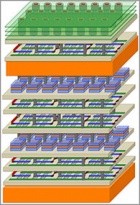material science News
Stanford-led skyscraper-style chip design could boost electronic performance by factor of a thousand
Wednesday, December 9, 2015
In modern computer systems, processor and memory chips are laid out like single-story structures in a suburb. But suburban layouts waste time and energy. A new skyscraper-like design, based on materials more advanced than silicon, provides the next computing platform.
New Battery Design Could Help Solar and Wind Energy Power the Grid
Friday, April 26, 2013
Researchers from the U.S. Department of Energy’s (DOE) SLAC National Accelerator Laboratory and Stanford University have designed a low-cost, long-life battery that could enable solar and wind energy to become major suppliers to the electrical grid.
Materials Scientists Make Solar Energy Chip 100 Times More Efficient
Tuesday, March 19, 2013
Scientists working at the Stanford Institute for Materials and Energy Sciences (SIMES) have improved an innovative solar-energy device to be about 100 times more efficient than its previous design in converting the sun's light and heat into electricity.
New optical tweezers trap specimens just a few nanometers across
Tuesday, December 4, 2012
A microscale technique known as optical trapping uses beams of light as tweezers to hold and manipulate tiny particles. Stanford researchers have found a new way to trap particles smaller than 10 nanometers - and potentially down to just a few atoms in size – which until now have escaped light’s grasp.
Engineering Hero Craig Barrett Talks Research Universities and Competitiveness
Monday, December 3, 2012
In an interview on the day of his induction as a Stanford Engineering Hero, Craig Barrett, a former professor in the School of Engineering who rose to be CEO/Chairman of Intel, reminisced about his career, the central role of research universities in America’s economic past and future, and how to remain competitive going forward.
Ann F. Marshall, 'a world-class electron microscopist,' wins the 2012 Marsh O'Neill Award
Friday, November 9, 2012
Award honors staff members who have made outstanding contributions to Stanford's research mission.
The Master of Materials
Friday, November 9, 2012
For Associate Professor Yi Cui, better materials mean better batteries, solar panels, renewable power storage and more.
Scratching the Surface: Stanford Engineers Examine UV Effects on Skin Mechanics
Thursday, October 4, 2012
Researchers in Stanford’s Department of Materials Science and Engineering are using models derived in mechanical labs to look closer at how ultraviolet radiation changes the protective functions of human skin.
Lights, nano, action: Advances in nanomaterials science and engineering
Wednesday, August 29, 2012
Assistant Professor of Materials Science and Engineering Jennifer Dionne discusses how engineers are controlling light at the nanoscale to treat cancer, create more efficient solar cells, develop a real-life cloak of invisibility and more.
Materials Science Assistant Professor Named a Top Young Innovator by Technology Review
Tuesday, August 21, 2012
William Chueh is recognized for his novel approach to solar fuel production.
Stanford engineers synthesize printable, electrically conductive gel
Thursday, July 12, 2012
The Jell-O-like material, from the labs of Stanford professors Yi Cui and Zhenan Bao, may have applications in areas as widespread as energy storage, medical sensors and biofuel cells.
Newly Upgraded Nanotechnology Labs Advance Science, Learning
Thursday, July 12, 2012
Stanford’s shared nanotechnology facilities offer state-of-the-art scientific instruments and trained staff that would be too costly for any single researcher to acquire.
Cloak and swagger: Engineers use plasmonics to create an invisible photodetector
Sunday, May 20, 2012
A team of engineers at Stanford and the University of Pennsylvania has for the first time used “plasmonic cloaking” to create a device that can see without being seen – an invisible machine that detects light. It is the first example of what the researchers describe as a new class of devices that controls the flow of light at the nanoscale to produce both optical and electronic functions.
Michel Boudart, chemical engineer and expert in catalysis, dies at 87
Monday, May 7, 2012
Professor Boudart taught at Princeton and Berkeley but was best known for his five decades at the heart of the Department of Chemical Engineering at Stanford. His influence shaped catalysis during the post-war period when energy, defense and space industries demanded a deeper understanding of chemical reactions.
Straintronics: Engineers create piezoelectric graphene
Thursday, March 15, 2012
By depositing atoms on one side of a grid of the “miracle material” graphene, researchers at Stanford have engineered piezoelectricity into a nanoscale material for the first time.
Frederick E. Terman Engineering Center is gone, but not lost
Wednesday, March 14, 2012
The Department of Project Management diverted 99.6 percent of the demolished Terman Engineering Center from landfill through recycling or reuse.
Sulfur in hollow nanofibers overcomes challenges of lithium-ion battery design
Monday, October 3, 2011
Yi Cui and his students have used sulfur-coated hollow carbon nanofibers and an electrolyte additive to fabricate a superior rechargeable lithium battery cathode. According to Cui, putting silicon nanowire anodes and sulfur-coated carbon cathodes into one battery could be the next generation in battery design.
Stanford engineers study 9/11 for lessons on how to help buildings withstand threats
Tuesday, September 6, 2011
Ten years after the attacks, engineers are experimenting with new technologies and designs to reduce the toll on life and property from human and natural threats.


















